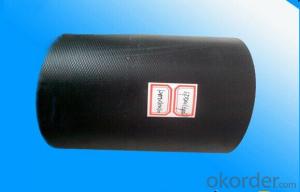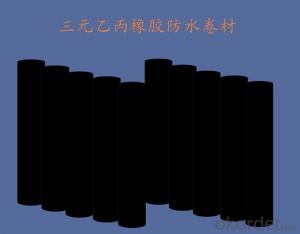Waterproofing EPDM Pond Liner for Garden/Lake/Pond Use
- Loading Port:
- Qingdao
- Payment Terms:
- TT OR LC
- Min Order Qty:
- 2000 m²
- Supply Capability:
- 100000 m²/month
OKorder Service Pledge
OKorder Financial Service
You Might Also Like
1. Product Introduction:
This waterproof coiled material is of high elasticity with best performance among high polumer
waterproof coiled material in the world.It is also the most typical one in the world.Waterproof coiled material made of ternary ethylene-propylene rubber is produced withthe use of the most advanced contiuous extrusion and vulcanization technology and related equipments which are specially designed for production of such product.It is good in compactness,without bubble and performance difference in length and breadth,perfomances reach or exceedthe demands of GB18173.1-2000 standard.
2. Product Specification:
There are two installation ways.one is full sticking,the other is hot welding.
Thick | 1.0mm,1.2mm,1.5mm,2.0mm,3.0mm or others |
Width | 1m to 4m |
Length | 20m |
Model | EPDM, EPDM with fabric |
3. Technical Sheet:
Number | Item | Unit | Value | |
1 | Size Variation | Thichness | % | ±10 |
Width | % | ±1 | ||
Length | % | Allowed negative | ||
2 | Breaking tensile strength at normal temperature | Mpa | ≥7.5 | |
Breaking tensile strength at 70°C | Mpa | ≥2.3 | ||
3 | Breaking elongation at normal temperature | % | ≥450 | |
Breaking elongation at -20°C | % | ≥200 | ||
4 | Tear strength | KN/m | ≥25 | |
5 | Impermeability(30min) | * | 0.3Mpa no leakage | |
6 | Bending at low tempreture | °C | ≤-40 | |
7 | Stretch tensor at heating | Elongate | mm | ≤2 |
Shrink | mm | ≤4 | ||
8 | Air oven aging(80°C×168h) | Tensile strength at break retained | % | ≥80 |
Elongation at break retained | % | ≥70 | ||
9 | Anti-alkali | Tensile strength at break retained | % | ≥80 |
Elongation at break retained | % | ≥80 | ||
10 | Nuture weathing at manual simulation | Tensile strength at break retained | % | ≥80 |
Elongation at break retained | % | ≥70 | ||
4. Features:
1. Waterproofing EPDM pond liner has excellent resistance to environmental stress cracking resistance, aging resistance, corrosion resistance as well as long service life.
2.Waterproofing EPDM pond liner has the lowest permeability
3. Waterproofing EPDM pond liner has high elongation,heat treatment the size change is small
5. Product Application:
EPDM waterproof membranes form an effective barrier to liquid water or water vapor in the roof construction for industrial and civil engineering, underground engineering such as subway & tunnel, water conservancy such as water pools & ditch, shelter, grain depot, land filling, dyke and subway.
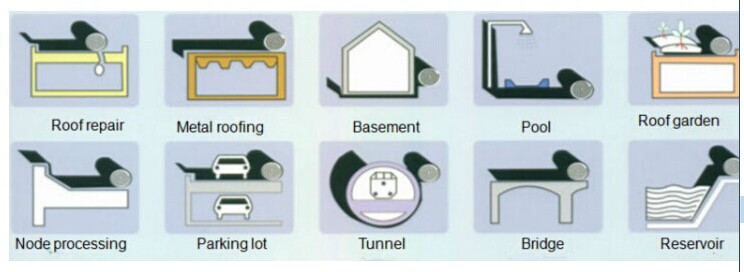
5. Some photos:
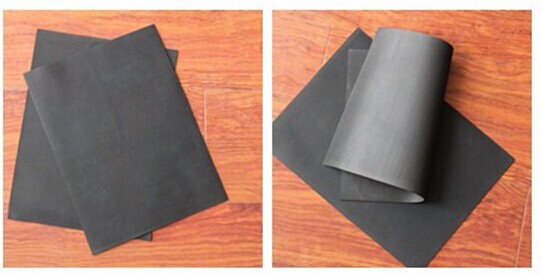
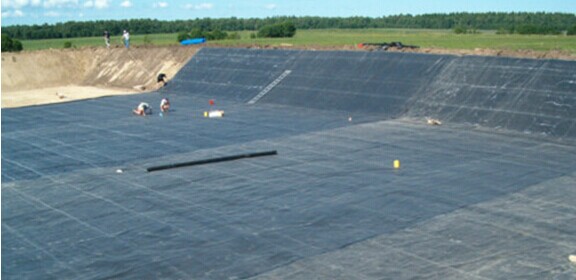
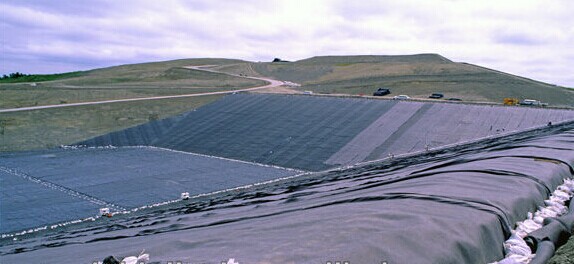
- Q:Can a waterproofing membrane be applied on both horizontal and vertical surfaces?
- Yes, a waterproofing membrane can be applied on both horizontal and vertical surfaces. Waterproofing membranes are designed to create a barrier that prevents water from penetrating through surfaces and causing damage. They are commonly used in various applications such as roofs, basements, bathrooms, and swimming pools. Whether it is a horizontal surface like a floor or a vertical surface like a wall, the waterproofing membrane can be applied to provide protection against water infiltration. The application process may vary depending on the specific surface, but there are membranes available that can be easily applied on both horizontal and vertical surfaces. It is important to follow the manufacturer's instructions and consult with professionals to ensure proper installation and effectiveness of the waterproofing membrane.
- Q:Can a waterproofing membrane be walked on?
- Walking on a waterproofing membrane is possible, but it depends on the type of membrane and its intended use. Some waterproofing membranes, like those used in roofing, are designed to withstand foot traffic without damage. These membranes are durable and can be walked on during installation and maintenance. However, it is crucial to follow the manufacturer's guidelines to ensure the membrane remains intact and provides effective waterproofing. On the other hand, certain types of below-grade waterproofing membranes may not be suitable for walking on as it could compromise their performance. It is advisable to consult a professional or refer to the manufacturer's instructions to determine if walking on a specific waterproofing membrane is safe and appropriate.
- Q:Can a waterproofing membrane be used in showers and wet areas?
- Certainly, one can indeed utilize a waterproofing membrane in showers and areas prone to moisture. In actuality, it is highly advisable to incorporate a waterproofing membrane in these regions as a means of averting water harm and leaks. The waterproofing membrane functions as a barrier between the tile or flooring and the underlying floor, guaranteeing containment and channeling of any water that infiltrates the surface towards the drains. This ensures preservation of the foundational structure by preventing moisture-induced damage like decay or mold proliferation. Moreover, a waterproofing membrane also serves to mitigate the risk of water seepage into nearby spaces and inducing harm to adjacent walls or floors. It is of utmost importance to ensure accurate installation of the waterproofing membrane, diligently sealing all seams, corners, and penetrations to achieve the desired level of waterproofing.
- Q:Can a waterproofing membrane be used on precast stone surfaces?
- Yes, a waterproofing membrane can be used on precast stone surfaces. The membrane acts as a protective barrier, preventing water from penetrating the stone and causing damage. It is commonly used in construction projects to ensure the longevity and durability of precast stone surfaces.
- Q:Can a waterproofing membrane be used for a parking garage deck protection?
- Yes, a waterproofing membrane can be used for parking garage deck protection. A waterproofing membrane helps to prevent water infiltration, which can cause damage to the parking garage deck over time. It acts as a barrier, protecting the deck from moisture and extending its lifespan. Additionally, it can also help to minimize the risk of corrosion and deterioration of the underlying structure.
- Q:Can a waterproofing membrane be used in kitchens?
- Yes, a waterproofing membrane can be used in kitchens. Waterproofing membranes are commonly used in areas prone to moisture, such as bathrooms and kitchens, to prevent water damage and leakage. They can be applied to various surfaces, including floors and walls, to create a waterproof barrier and protect against water infiltration. By using a waterproofing membrane in kitchens, one can ensure the longevity and durability of the space while preventing potential water-related issues.
- Q:How long does a waterproofing membrane last?
- There are several factors that can affect the lifespan of a waterproofing membrane. Typically, a waterproofing membrane that is installed properly and maintained well can endure for 10 to 20 years. However, this timeframe can be influenced by various elements such as the quality of the membrane material, the extent of exposure to environmental elements, the frequency of foot traffic or other sources of strain, and the overall level of maintenance and care provided. It is important to emphasize that regular inspections and maintenance play a vital role in extending the lifespan of a waterproofing membrane. Furthermore, adhering to the guidelines and recommendations provided by the manufacturer can ensure optimal performance and enhance the longevity of the membrane.
- Q:Can a waterproofing membrane be used in renovation projects?
- Yes, a waterproofing membrane can be used in renovation projects. It is a common and effective method to prevent water damage and leakage in areas such as basements, bathrooms, and roofs during the renovation process. By installing a waterproofing membrane, it helps create a barrier against water penetration, ensuring the longevity and durability of the renovated area.
- Q:What are the potential drawbacks or limitations of using a waterproofing membrane?
- One potential drawback of using a waterproofing membrane is the potential for improper installation. If the membrane is not installed correctly, it can lead to leaks and water damage. It requires a certain level of expertise and attention to detail to ensure that the membrane is properly applied and sealed. Another limitation is that waterproofing membranes can be relatively expensive compared to other waterproofing methods. The cost of purchasing and installing the membrane, as well as any necessary maintenance or repairs, can add up quickly. This may make it less feasible for some budget-conscious individuals or organizations. Additionally, waterproofing membranes are not a one-size-fits-all solution. Different types of membranes are suitable for different applications, and it is important to choose the right one for the specific requirements of the project. This requires knowledge and understanding of the various options available, which can be a challenge for those without experience in the field. Another potential drawback is the limited lifespan of waterproofing membranes. Over time, they can deteriorate or become damaged, which may require replacement or repairs. This can be costly and time-consuming, especially if the membrane needs to be removed and replaced in order to fix the issue. Lastly, waterproofing membranes are primarily used for below-grade applications or on horizontal surfaces such as roofs or decks. They may not be as effective for vertical surfaces such as walls or in areas where there is significant movement or stress, such as expansion joints. In these cases, alternative waterproofing methods may be more suitable. In summary, while waterproofing membranes offer excellent protection against water intrusion, they also come with potential drawbacks and limitations such as improper installation, high cost, need for expertise in selection, limited lifespan, and limitations in application. It is important to weigh these factors and consider alternative options before deciding on a waterproofing solution.
- Q:Can a waterproofing membrane be used in areas with high foot traffic or heavy loads?
- Yes, a waterproofing membrane can be used in areas with high foot traffic or heavy loads. Waterproofing membranes are designed to provide a protective barrier against water infiltration and can withstand various types of stress, including foot traffic and heavy loads. However, it is important to choose a waterproofing membrane that is specifically designed for these conditions. There are different types of membranes available, each with varying levels of durability and strength. It is crucial to consult with a professional waterproofing expert or manufacturer to ensure that the chosen membrane is suitable for the specific requirements of the area with high foot traffic or heavy loads. Proper installation and maintenance of the membrane are also essential for its long-term effectiveness in these conditions.
1. Manufacturer Overview |
|
|---|---|
| Location | |
| Year Established | |
| Annual Output Value | |
| Main Markets | |
| Company Certifications | |
2. Manufacturer Certificates |
|
|---|---|
| a) Certification Name | |
| Range | |
| Reference | |
| Validity Period | |
3. Manufacturer Capability |
|
|---|---|
| a)Trade Capacity | |
| Nearest Port | |
| Export Percentage | |
| No.of Employees in Trade Department | |
| Language Spoken: | |
| b)Factory Information | |
| Factory Size: | |
| No. of Production Lines | |
| Contract Manufacturing | |
| Product Price Range | |
Send your message to us
Waterproofing EPDM Pond Liner for Garden/Lake/Pond Use
- Loading Port:
- Qingdao
- Payment Terms:
- TT OR LC
- Min Order Qty:
- 2000 m²
- Supply Capability:
- 100000 m²/month
OKorder Service Pledge
OKorder Financial Service
Similar products
New products
Hot products
Hot Searches
Related keywords

